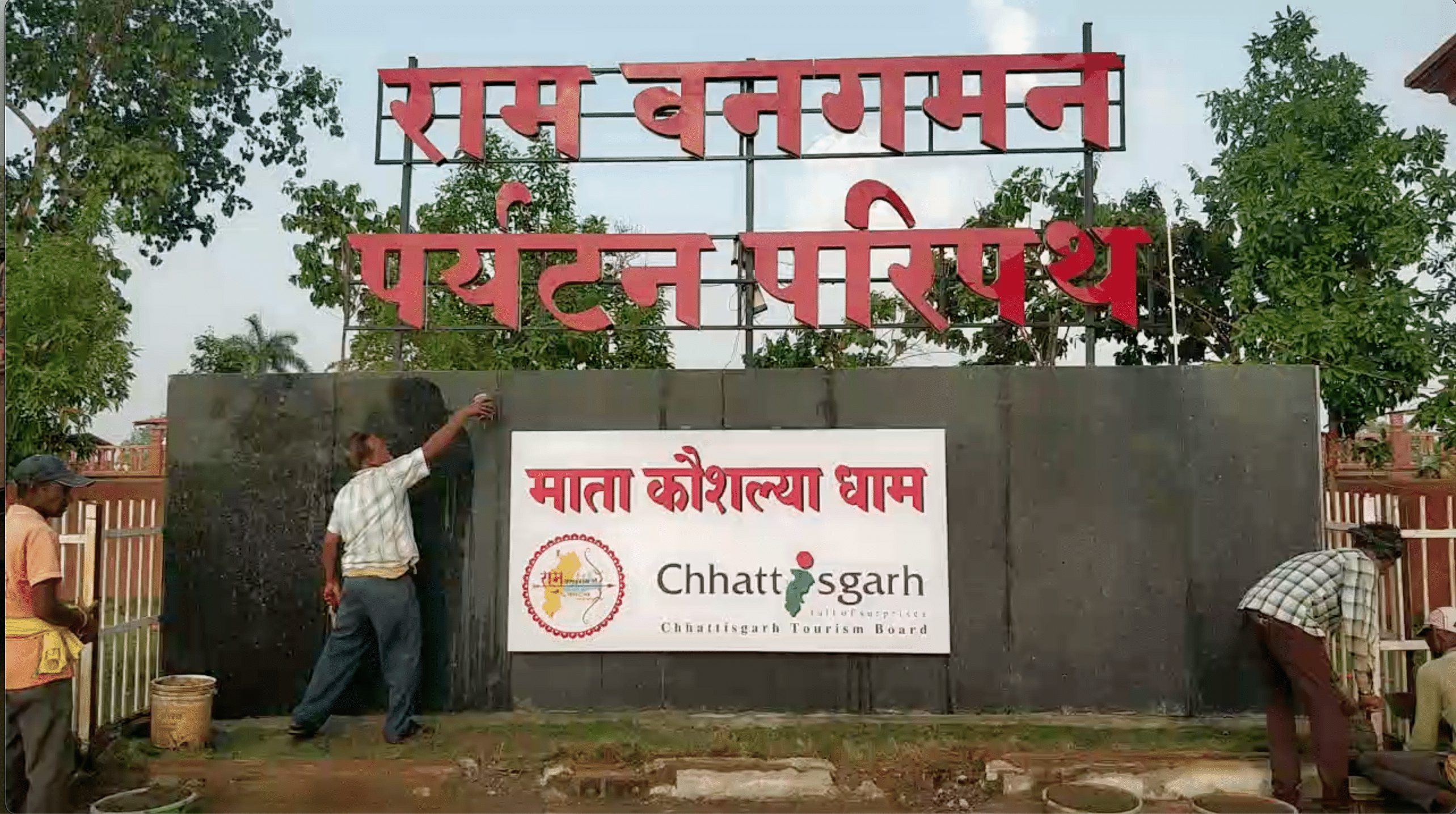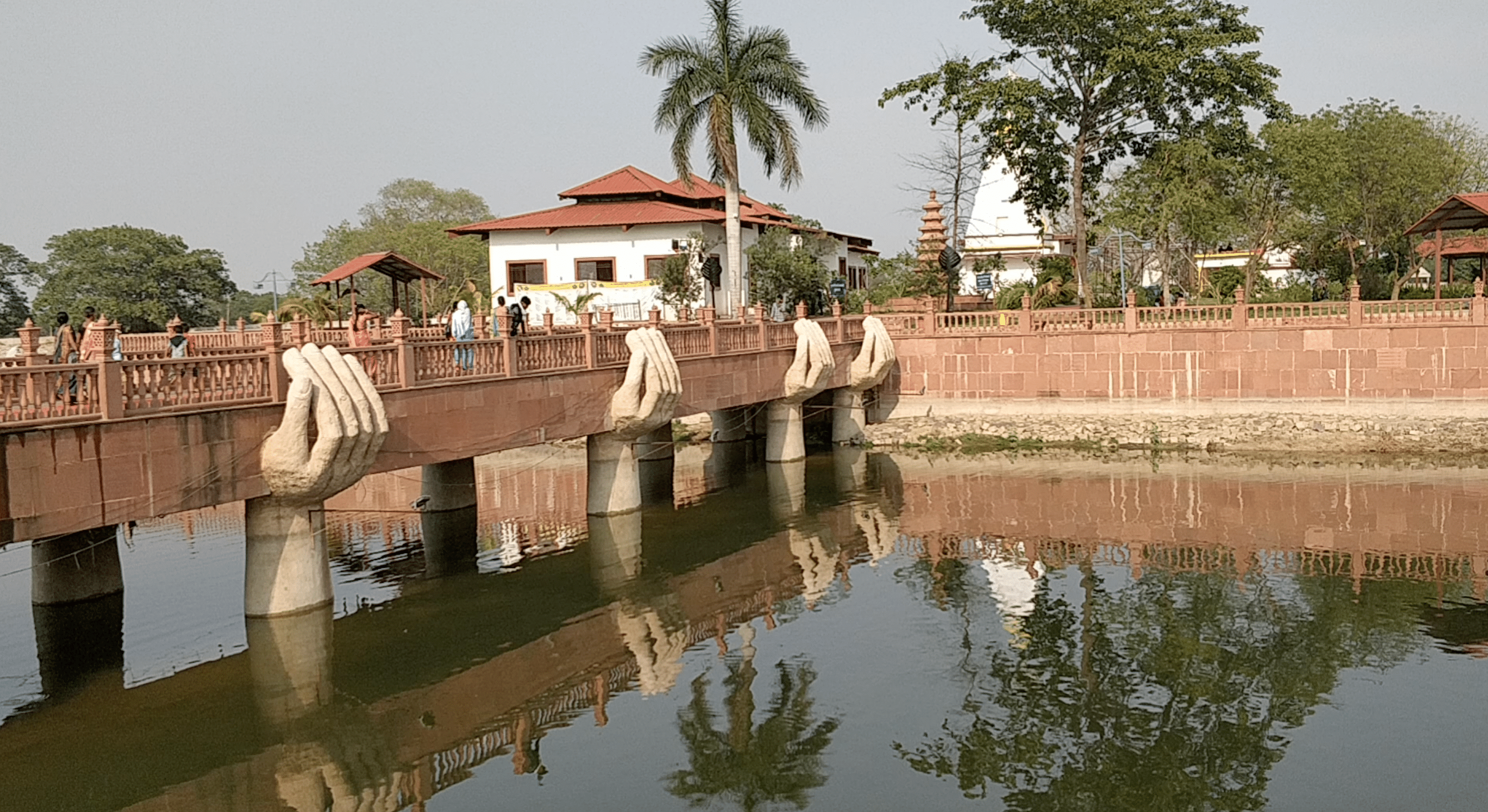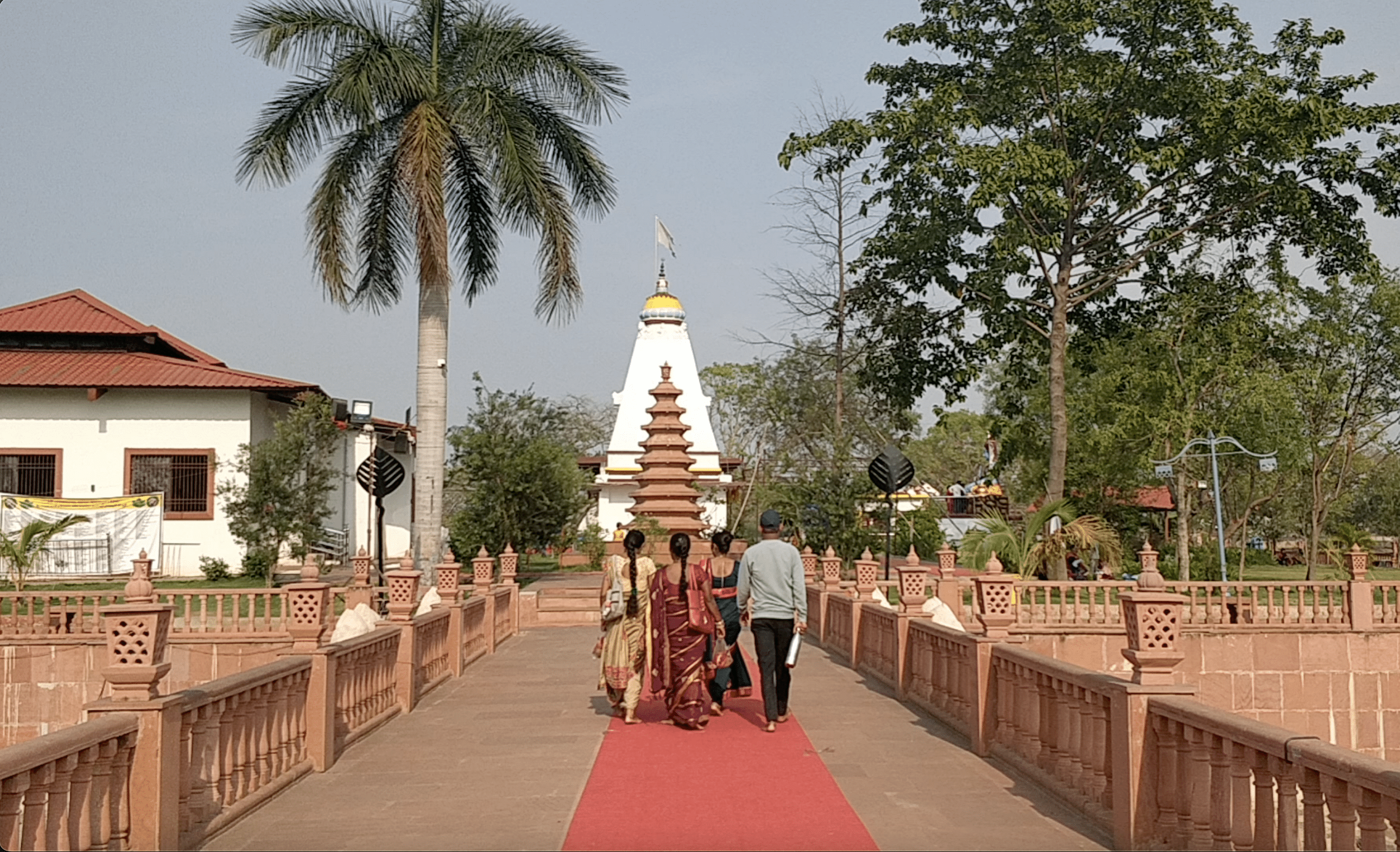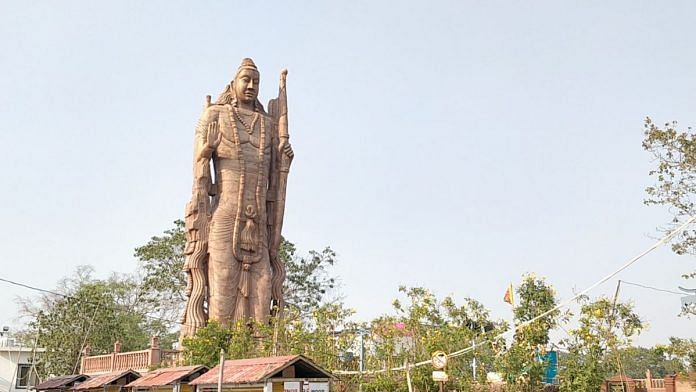Chandkhuri: A bridge, a 65-foot statue of Ram, fountains, and lights have put Chhattisgarh’s Kaushalya Mata Mandir on India’s religious tourist map. An obscure island temple in Chandkhuri village on the outskirts of Raipur is now a bustling tourist destination. But few local residents or tourists know that the only temple in the world dedicated to the Hindu god’s mother, Kaushalya, is part of the Congress government’s ambitious Ram Van Gaman Paripath corridor. The project connects all sites where Ram stopped during his exile.
Kaushalya Mandir is an important milestone in Chief Minister Bhupesh Baghel’s politics of Hindu symbolism, which began with the sale of cow dung, a budget briefcase made from cow dung, and the promotion of cow urine products. He had even mandated the painting of all government buildings using materials derived from cow dung. Notably, he initiated the temple renovation project in July 2020, just days before the foundation ceremony of Ayodhya’s Ram Mandir. A considerable portion of the work has already been completed in the run-up to the assembly election, scheduled for later this year, alongside Rajasthan and Madhya Pradesh.

But Kaushalya Mandir is not Ayodhya. The demand for its development came not from the RSS-VHP-BJP, but from intellectual Hindu circles. The Congress hasn’t been promoting it, or pushing for media coverage. The BJP’s silence is equally telling, despite the project aligning with its push for temple corridors.
“They are uncomfortable with us developing Kaushalya Mandir. They ask us to prove if she (Ram’s mother) was born here,” declared Baghel during his visit to the complex for the ‘Kaushalya Mata Mahotsav’ in April. He further accused the BJP of doing nothing for the development of the Ram corridor in Chhattisgarh over the past 15 years. “They don’t like that we are now working on the Ram corridor,” he added.
Baghel even publicly taunted RSS chief Mohan Bhagwat in September of last year and expressed his ‘hope’ that the Sarsanghchalak would visit the newly developed temple. Bhagwat did visit Kaushalya Mandir the same month.
Chhattisgarh’s Ram corridor
Villagers in Chandkhuri are amazed at how their humble temple has transformed within a short period.
“Just three years ago, there was only a rickety wooden bridge here. People used to swim across the lake for darshan. It looks fantastic now,” said Neeta Verma, a school teacher, expressing her approval of Kaushalya Mandir.

In the autumn of 1975, Ramendra Mishra, a history professor and member of the Chhattisgarh Asmita Sansthan, a cultural organisation, rode his scooter for 35 kilometres to Chandkhuri. He swam across the pond and excavated an unassuming idol, which he identified as Kaushalya. “There were idols lying around on that small island. Villagers knew about it and I followed up on it,” said Mishra, pulling out an old diary entry where he documented the discovery of the female idol. A small temple was built, marking the inception of Kaushalya Mandir.
For citizens demanding a separate state, the idol was proof that Chhattisgarh, which was then part of Madhya Pradesh, was once called Dakshin Koushal. Twenty-five years later, on 1 November 2000, Chhattisgarh separated from Madhya Pradesh.
For years, the temple remained neglected. Villagers remember how people used to swim to the temple for darshan until a wooden bridge was later constructed. However, over time, its condition deteriorated, and many individuals continued to swim to worship at Ram’s maternal house.
Everything changed in 2019 when Baghel visited the temple and recognised its true potential.
“He saw a big flex of the map that I had installed in front of the temple and decided it could be a development project. Later, we were interviewed and the Congress government took away our research and maps,” said BJP leader Shyam Bais, general secretary for Ram Van Gaman Paripath Shodh Sansthan , an organisation credited with tracking down all 75 locations that Ram had visited during exile.
Today, the rickety wooden bridge has been replaced by a sandstone causeway that connects the temple to the mainland. Two statues emerge from the lakebed—one of Ram and another of Samudra Manthan. As part of the project, a court by King Koushal, Kaushalya’s father, has also been built.
With this, the Baghel government is fulfilling a long-pending demand of Hindutva followers in the state, but many doubt if he will get any political mileage out of it.
Within Chhattisgarh, awareness about the Ram Van Gaman Path is low, and the government has done little to remedy this. Hoardings and billboards with the CM’s photograph list various schemes like the unemployment scheme and electricity subsidy. But Kaushalya Mandir is nowhere to be found.
“The Kaushalya Mandir is a nice new tourist spot. I didn’t know it was part of the Ram corridor,” said Varsha Bansal of Raipur after visiting the temple.
Since coming to power, the Congress has been stressing on Chhattisgarh’s cultural identity with the tagline ‘Garbho nava Chhattisgarh’ (we will build new Chhattisgarh) “The focus is on Chhattisgarhiyat, our cuisine and folk songs… and Ram is an important part of it,” said Sushil Kumar Trivedi, political commentator and former Chief Election Commissioner of the state.
“Notice that they’ve called it a tourist corridor and not a religious outreach. This is because Baghel knows this cannot contest with Ayodhya’s Ram Mandir and that soft Hindutva cannot be an answer to BJP’s hard Hindutva,” he added.
And while the Congress may be walking the political tightrope of temple versus tourism, the Kaushalya Mandir is Baghel’s pet project — a Hindu outreach after a number of communal flare-ups among Christians and tribals as well as Hindus and Muslims in the run-up to the election.
A senior Congress leader said that the project is close to the chief minister even if it doesn’t suit the party’s politics, “The chief minister is a religious man, a devotee. This project is personal,” the leader said.
The BJP is studiously skirting around the temple and the corridor, but the Centre had to recognise Chhattisgarh’s project in Parliament. When BJP MP Rajyavardhan Singh Rathore asked about the status of a Ram Van Gaman Path in the country, Union Culture Minister G Kishan Reddy replied that no such project by the central government was underway but that Chhattisgarh was building one.
Later, the Centre announced that Chitrakoot in Madhya Pradesh is being developed under the Ramayana circuit to be built by the tourism ministry under the Swadesh Darshan Scheme.
Also read: Nitish Kumar to Bhupesh Baghel, Opposition redrawing Mandal vs Kamandal battleline for 2024
A long-standing demand
Chhattisgarh is believed to be the nanihal (maternal grandfather’s house) of Ram. It is also widely believed that he spent 10 of his 14 years in exile traversing the jungles of the area.
In 2008, a group of writers, politicians, historians, archaeologists got together to chart out the path Ram followed during his peregrinations. They identified 75 key locations from the northernmost district Koriya to Sukma in the south where Ram, Lakshman, and Sita are believed to have passed through, according to the map of the corridor.
The demand for the corridor is as old as the demand for Chhattisgarh. “During the movement for a separate state, we were looking for ways to glorify the Chhattisgarhiya identity, and our organisation, Chhattisgarh Asmita Sansthan led by Dr Yadu, started working on identifying the Ram Van Gaman Path,” claims Mishra. The Sansthan, founded in 1995, supported the recognition of Chhattisgarh as a separate state.
The Chhattisgarh government has spent Rs 165 crore so far in developing the corridor. Of the 75 locations, nine—including Shivrinarayan in Janjgir-Champa, Jagdalpur in Bastar, and Sihava Saptarishi Ashram in Dhamtar—are in the first phase. They will have over 60 ft tall statues of Ram and cafes serving traditional Chhattisgarh food. The temple walls will have murals depicting stories from the Ramayana. Most of the work has been completed, with the government claiming that tourist footfall has increased ten-fold in these sites.

Whose project is this
CM Baghel may have executed the corridor project, but the Ram Van Gaman Paripath Shodh Sansthan claims it had laid the foundation for it as early as 2008. Bais, its general secretary, said that he and other members had worked on the route map for a decade. Historians, archaeologists, geologists and experts from related fields all contributed to the research.
The organisation published various booklets about the locations Ram visited as well as a book titled Chhattisgarh Ramayana. It was written by late Manu Yadav, the head of Ram Van Gaman Paripath Shodh Sansthan. Former chief minister Raman Singh has written an essay in the preface of the book.
“We kept Raman Singh duly informed about the project and about our research,” Bais said, and claimed that in 2019, the Baghel government took their maps and research work. “Nobody from our organisation was consulted in the development of the corridor,” Bais said.
The BJP now claims the Congress appropriated a plan it had developed.
“Who gave the name Ram Van Gaman Path? It was the Bharatiya Janata Party. The research used by them was conducted by three committees that we had established,” said Amit Chinmani, Chhattisgarh BJP spokesperson.
However, Bais says the Ram Van Gaman Paripath Shodh Sansthan was never in touch with the BJP’s Raman Singh government regarding the project. “It doesn’t matter which government is developing the corridor. Things only happen at the correct time.”
The tourists and devotees at the temple are not weighed down by these claims and counterclaims. For them, Ram’s maternal home is the perfect day trip. After visiting the temple and offering prayers, they spend time in the garden taking selfies and photographs.
(Edited by Ratan Priya)



